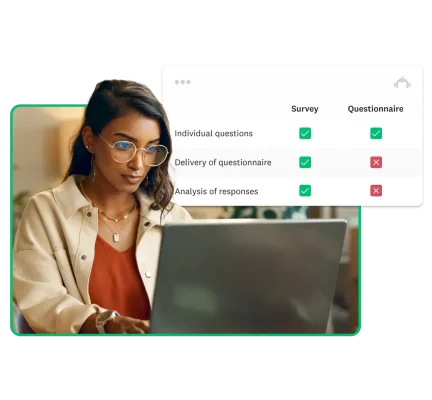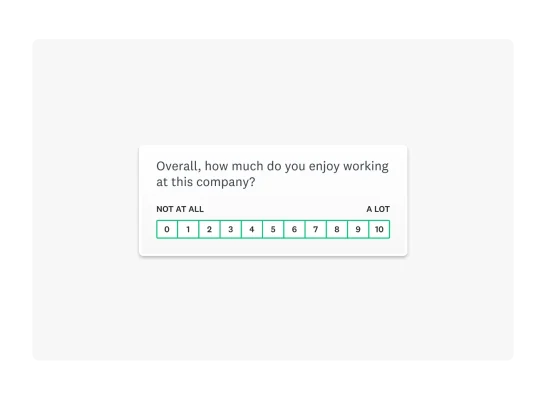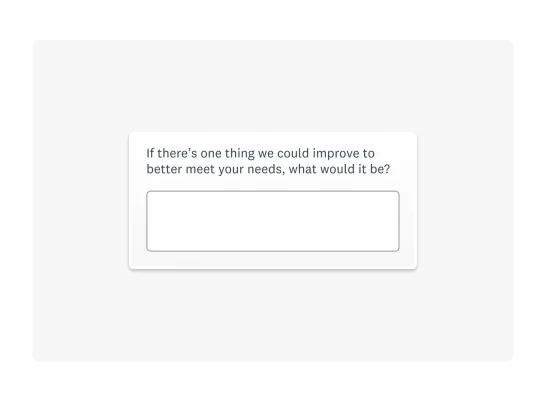What is a questionnaire? Definition, examples, and uses
Utilize questionnaires to conduct market research and help scale your business.

- The purpose of questionnaires in research is to systematically collect data for analysis and conclusions
- Surveys can be descriptive, analytical, or exploratory, each serving different research purposes.
- Questionnaires are used within surveys to collect data from respondents, making them a component of the broader survey process.
Questionnaires are an effective research tool for efficiently collecting data. They play a crucial role in market research, employee satisfaction assessments, and feedback gathering, offering a versatile method for obtaining detailed information from respondents.
This article explores different types of questionnaires, their benefits, and the distinctions between questionnaires and surveys, with relevant examples.
What is a questionnaire?
A questionnaire is a research tool that gathers quantitative or qualitative information from respondents through a series of questions or prompts. They often consist of open-ended and closed-ended questions to diversify the information gathered.
Businesses use questionnaires in various scenarios ranging from employee satisfaction to lead product development. Keep reading to learn about surveys vs. questionnaires and when to use each type of questionnaire.
Are questionnaires and surveys the same thing?
Questionnaires and surveys are different. There are objective differences between the research tools, which we will explore later in this article.
Types of questionnaires
There are three primary types of questionnaires: structured, unstructured, and semi-structured. The different types of questionnaires serve their own purposes and are designed with distinct goals.
Structured questionnaires
The purpose of a structured questionnaire is to gather quantitative data or information that can be measured and expressed numerically.

Businesses use structured questionnaires to systematically collect valuable data to inform decision-making. For instance, a Customer Satisfaction (CSAT) questionnaire can be used to measure and improve the customer satisfaction of your products, services, or customer service.
A structured questionnaire has the following attributes:
- Predefined questions. The questions are predetermined and formatted in a structured questionnaire before sending the questionnaire. This ensures respondents get a standardized experience.
- Quantifiable responses. The questionnaire is designed to produce quantifiable results that can be analyzed and considered to inform business decision-making.
- Closed-ended questions. Close-ended questions are a trademark of structured questionnaires. Respondents choose answers based on predefined options such as rating scales (e.g., 1 to 5), Likert scales (e.g., strongly agree to strongly disagree), multiple-choice, etc. The responses to closed-ended questions are easier to quantify than open-ended responses.
- Consistent layout. Structured questionnaires have a uniform format, ensuring all respondents receive the same questions in the same order with identical response options. This approach ensures consistency and higher reliability of the results.
Unstructured questionnaires
Unstructured questionnaires are used to collect qualitative data or non-numerical information. This type of questionnaire relies on open-ended questions. Responses are not predetermined like structured questionnaires.

Businesses use unstructured questionnaires to collect nuanced information from customers, employees, or target markets. This information can include details about a customer’s experiences with a brand or descriptions of an employee’s roadblocks.
For example, a business may send an unstructured questionnaire to employees to gather feedback on workplace culture. This questionnaire may seek to understand employees' perceptions of team collaboration, leadership commitment, and overall morale.
The following characteristics are common in unstructured questionnaires:
- Open-ended questions. Unstructured questionnaires collect responses using open-ended questions. Respondents can give answers without confines.
- In-depth responses. Open-ended questions in unstructured questionnaires elicit detailed feedback that can be used to address customer and employee pain points.
- Flexibility. Flexibility is also a common theme in this type of questionnaire. Without a predefined set of answers, the format of unstructured questionnaires can vary widely.
- More complexity. With less standardization in unstructured questionnaires comes higher levels of complexity and nuance in responses. This can be a benefit or a challenge, as analyzing open-ended responses can be more complex than quantifying data.
Semi-structured questionnaires
Semi-structured questionnaires combine elements of structured and unstructured questionnaires to balance standardization and flexibility.
Businesses may use a semi-structured questionnaire for exploratory research. This format allows businesses to glean quantitative and qualitative data that can improve decision-making.
Semi-structured questionnaires generally have the following characteristics:
- Qualitative and quantitative data. The results include qualitative and quantitative data. This can give researchers a more balanced view of their audience and allow for more in-depth observations.
- Consistency and depth. The mix of open-ended and closed-ended questions balances consistency and depth. Researchers can provide a consistent format with set questions, allowing for more in-depth responses.
- Guided format. A semi-structured questionnaire ensures that goals are met by providing predefined questions that guide the conversation. This ensures that all key topics are addressed consistently across respondents.
Why use a questionnaire?
Teams can use questionnaires strategically to conduct business research, whether conducting product development research or gathering employee feedback.
Questionnaires offer several benefits to you and your team, including:
- Cost-effective. Sending online questionnaires is a cost-conscious way to conduct research. Other research methods, like focus groups, incur expenses that questionnaires do not, like travel fees. This is a major benefit to consider when thinking about how to gather feedback for your business.
- Time efficient. Questionnaires are also time-efficient to make. SurveyMonkey makes creating professional questionnaires a breeze with questionnaire templates.
- Scalable. If you’re looking to gather data from diverse consumers, questionnaires are scalable. Research questionnaires can be distributed to many people without much additional effort.
- Data variety. You can gather a wide range of data with questionnaires. For instance, you can use semi-structured questionnaires to gather quantitative and qualitative data. This allows you to collect significant data from your target audience to analyze and use in decision-making processes.
- Anonymity. Questionnaires can be anonymous. This allows for more candid and accurate respondent feedback.
What is a questionnaire in research?
A questionnaire is a research tool used to collect feedback from a specific group of people. It consists of various questions on a topic researchers wish to evaluate. The data is collected and analyzed to draw conclusions backed by research.
Questionnaires are fundamental to conducting market research. Market research provides insight into target customers, including sentiments, behaviors, preferences, and more. It drives business growth through data analysis and helps answer questions such as:
- How does my brand compare to the competition?
- Which demographics are most likely to buy my product or service?
- How big is the market opportunity for my product or service?
Sending questionnaires as a part of your market research project is cost-effective and can yield significant results in a short period.
Examples of questionnaires in research
Some examples of questionnaires in a research context include:
- Gathering customer demographic data. The purpose of a customer demographic questionnaire is to collect information about a sample group to inform your understanding of a specific population. Customer demographic data, such as occupation, age, income level, education level, etc., can be highly beneficial in creating buyer personas and personalizing the customer journey.
- Collecting consumer preferences. Consumers’ preferences and opinions about competitors can inform your marketing strategy and product development. Questionnaires give your team a better understanding of what your target customers value in products and brands that they love. This information can be used to adjust your strategy, ranging from advertising to your website’s user experience (UX).
- Measuring customer satisfaction. To be a successful business, you must monitor your customers’ satisfaction levels. Use questionnaires at different customer touchpoints to evaluate and measure customer satisfaction. This ensures that your company provides value to customers and helps protect brand reputation.
- Evaluating employee experience. Employees are vital to any business; keeping them motivated and productive is essential for growth. Employee experience (EX) questionnaires measure employee satisfaction and morale to find improvement areas. Employee feedback helps create initiatives that drive productivity and boost efficiency.
Use questionnaires to inform your decision-making process. Check out our 150+ questionnaire templates.
Benefits of using questionnaires in research
Research questionnaires are widely used in market research for several reasons. Their benefits make them integral to many companies’ market research processes. These benefits include:
- Easy to scale. Questionnaires can be easily distributed to broad audiences to collect large amounts of data. This scalability enables researchers to gather customer feedback in various geographic locations to get a more diverse sample. The value of this lies in streamlining data collection without additional effort.
- Efficiency. As mentioned previously, questionnaires are an efficient means of conducting research. They can be created in minutes and sent online, creating a seamless process for researchers. Data can be collected in real time to inform a company’s research.
- Less researcher bias. Questionnaires leave little room for researcher bias as opposed to in-person or virtual focus groups or interviews. Respondents answer the questions independently and are not influenced by the researcher as they might be in a focus group or interview. The removal of researcher bias makes questionnaire results more reliable and trustworthy.
- Standardization. Standardization also plays a role in the reliability of questionnaire results. Since many questionnaires are more rigid in structure and are standardized across respondents, the results are typically reliable. Each respondent is asked the same questions in the same order, creating consistency and reliability in the data.
What is a survey questionnaire?
A survey questionnaire collects data about respondents' opinions, behaviors, or characteristics. Survey questionnaires often include questions designed to elicit detailed responses relevant to a particular survey's objectives. A survey questionnaire is purpose-driven, meaning it was designed to address a specific objective or question.
What’s the difference between a survey and a questionnaire?
Surveys and questionnaires are often used interchangeably. However, they are two distinct research tools. We will address the similarities and differences between surveys and questionnaires.
Similarities between surveys and questionnaires
Surveys and questionnaires are frequently seen as the same thing. This is fair since they do share commonalities. The similarities between surveys and questions include:
- Question-based. The most significant commonality between these research tools is that they are question-based. Surveys and questionnaires use questions to gather respondents' information, making it easy to assume they are terms for the same process.
- Used to collect data. Another similarity is that they both are used as vehicles to collect data. Surveys and questionnaires gather information from a target audience to inform their research.
- Analysis. Researchers then analyze the information and data received from surveys and questionnaires. The data collected is analyzed similarly for both surveys and questionnaires.
- Research applications. Lastly, the research applications often overlap with surveys and questionnaires. These two research tools can be used in market research, to gather employee feedback and customer opinions, or in academic studies.
Differences between surveys and questionnaires
While they seem similar, surveys and questionnaires have a few differences that distinguish them.
Questionnaires are specific sets of questions designed to collect data from respondents. They are typically used as tools within broader surveys.
Conversely, surveys refer to the process of collecting, analyzing, and interpreting data, which may involve questionnaires and other methods like interviews or observations.
The scope of questionnaires is limited to the questions asked, while surveys encompass the entire research methodology and data analysis.
In essence, questionnaires are a component of the survey process. Surveys provide a comprehensive approach to gathering and understanding information on a topic.
Launch a questionnaire with SurveyMonkey
Interested in collecting data from an online questionnaire or survey? SurveyMonkey makes it easy. We offer the tools to send professional surveys and questionnaires to conduct market research or collect feedback.
Sign up today and get started by checking out our survey templates.
Discover more resources

Toolkits directory
Discover our toolkits, designed to help you leverage feedback in your role or industry.

How to make your data collection more secure

Boost survey response rates with these 20 email templates
Enhance your survey response rates with 20 free email templates. Engage your audience and gather valuable insights with these customizable options!

P-value calculator: How to calculate p-value
Leverage our p-value calculator to find your p-value. Plus, learn how to calculate p-value and how to interpret p-values with our step-by-step guide.